Travel Notes: Gdańsk - Day 2
2025-03-15 11:27 amTitle: Travel Notes: Gdańsk
Author:![[personal profile]](https://www.dreamwidth.org/img/silk/identity/user.png) rodo
rodo
Chapter: 2/5
Length: 1977 words
Rating: 6+
Genre: travelogue
A/N: feel free to read; I wrote this mainly for myself, to better remember my time in Gdańsk
Summary: In the summer of 2024, I found myself with time and money to spend, and on short notice, decided to visit Gdańsk, a city I’d never been to, but had always wanted to see. Here, you can read all about my trip – the boring and hopefully not so boring details, illustrated by a couple of photos.
Day 2: Monday, 29th of July 2024: Getting Started
All was not better the next day. Shortly after midnight, I still wasn’t asleep, and I was in so much pain I was about to walk downstairs and ask for a doctor. It was one of the worst headaches I ever had in my entire life. As a last resort, I took an ibuprofen (with extra caffeine) for the pain and laid back down. And miraculously, I fell asleep.
The next morning, the pain was almost gone, but I still felt sick, tired and exhausted. I had a stuffy nose as well, which meant I was struggling with my allergies on top of the headache and stiff muscles. I wasn’t sure whether I was going to be able to do much of anything when I got up. I just had one last hope: breakfast. To be more precise: coffee. I schlepped myself downstairs, asked where the buffet was and got myself a large coffee with it. And then another, for good measure. Half an hour later, as if by magic, I felt like a human being again, and I was able to head out after all. I had three things on my itinerary for the day: get złoty, get my bearings, and acquire some postcards to send back home. I left the hotel around 9 o’clock.
First, I walked back towards the station, looking for either an ATM or a Kantor – a place for exchanging money. I passed by the cosmetic surgery clinic, then the other hotel, and then I reached a bank with an ATM where I withdrew two hundred złoty. The Kantor across the street was still closed. More than that, the entire city seemed to be somewhat sleepy, still. A couple of tourists were milling about, and other people were going to work, but apart from that, not much was happening. It was the perfect time to just walk around for a bit – much calmer and fewer distractions than later on.
I walked into the street that was still cordoned off for car traffic and it didn’t take me long to get an idea of what was going on: on the street, there were a lot of stalls – mostly still closed or in the process of being set up – selling this and that. There was a market of some sort in town. Of course, it took me at least another hour of aimlessly walking around to spot the sign that told me what exactly was going on. It was St. Dominic’s Fair. I had never heard of it and hadn’t know it was happening at all, but every year starting in late July, Gdańsk hosts one of the biggest fairs of this kind in Europe. It dwarfed all the Christmas markets I’d been to and was spread out all over the city centre like a kraken crawling through the streets. I didn’t truly get a good grip on just how big it was for another day when I’d finally gotten an idea of the city’s layout. There were stalls for pretty much everything: beer, honey, kielbasa, cheeses, nougat, handcrafts of all sorts… it was quite overwhelming, in the best way.
But I had gotten distracted: I still had a mission that morning: first, I needed postcards. And I wanted to exchange some of my euros. I walked past at least another two Kantors that were either still closed or unmanned, meandering through the narrow cobblestone streets and looking at what the stalls had on offer until I eventually ended up at the Motława, the river flowing through Gdańsk and into a branch of the Vistula. I also finally caught a glimpse of Gdańsk’s most famous building, the port crane.
Gdańsk, once upon a time, was one of the most important Hanseatic cities in the Baltic. The Hanseatic League – for those of you who don’t know – was a sort of medieval trade federation that at one point was powerful enough to win a war against the king of Denmark. For that reason, it boasts some of the most impressive Brick Gothic architecture I’ve seen, as well as many merchant houses, richly decorated. It was also the reason the crane was constructed, originally (the current building is a post-war reconstruction, as are many buildings in Gdańsk) – its name tells you something about its function. It was used to load and unload ships, as well as mount masts on ships. Its German name (“Krantor”) is somewhat more informative. “Crane Gate”, since you can walk through it and marvel at the wooden wheels that could move tons. It’s not pretty, exactly, but it is a very unique building, one that I find beautiful because of its function, despite being a bit squat and plain.
Near the crane, I finally found a gift shop. One that was open, even. It sold the most cliched tchotchkes imaginable, and also postcards. I bought myself my first souvenir (a magnet with an image of the waterfront, prominently featuring the crane) and a couple of postcards. The person manning the shop was a bored teenager on her summer job, and she clearly wished the tourists would just go elsewhere – maybe not that great for the shop, but honestly, I could relate. She did at least tell me where I could get my hands on a couple of stamps: near Neptune’s Fountain.
Well, as it turned out, that was a tad more difficult to find than I imagined. After a short break to figure out who would get what card, I wrote a couple of sentences on each. Then I went looking. I found the Neptune statue easily enough – it’s one of Gdańsk’s main tourist attractions, Poland’s oldest working fountain and part of the Long Market, alongside a lot of pretty historic buildings, including the Artus Court and numerous other Renaissance buildings. One of those is the Main Town Hall, a beautiful reconstructed building with a carillon in the main tower that rang when I passed by at 11 o’clock. By that time, the tourists were out in full force, which meant I had to walk back and forth a little until I found my target in the adjacent Long Lane, with just as many pretty houses. The stylized posthorn was what tipped me off.
Inside the post office, there was an open room with ancient standing desks and seats in the middle, while the room was lined with counters behind bars. It’s been a while since I’ve seen a post office like that outside of movies, so I probably stared a little too long before finally figuring out where to draw my number and waiting my turn. I didn’t have to wait long, and despite not quite understanding what the woman on the other side of the counter said, I got three stamps, put them on the postcards and then shoved everything into the red postal box outside, hoping I did everything right.
In the Long Lane, I also finally found a Kantor that was open for business and exchanged a hundred of my euros for złoty, which meant I could finally relax. My tasks for the day were done. It was time to head back to the hotel to relax a little, so I did just that. I walked across the fair again, mentally marked a stall to buy something for a friend later and finally made a stop at the shopping centre near my hotel, which contained a Danish Netto, which I’d never been to before, but had heard good things about. There, I bought some peanuts and a bottle of Żubrówka (my late grandfather’s favourite vodka) to take back home with me.
After getting back to the hotel, I spent three hours napping. My head needed it.
To be sure, the first thing I did when heading back out was to get another coffee. The option closest to the hotel was a Starbucks, and I ordered an Iced Cold Brew coffee. Tall. I got a plastic cup with the aforementioned beverage, even if the name on it was “Doitia”, which in true Starbucks tradition is very much not my name, and not even close to the Polish version of it.
Properly caffeinated, I set off in search of a place to eat. Both the guidebook and the internet were raving about a pierogi/mandu restaurant, but since I hadn’t fully oriented myself, it took a while to get there. I paused near the Great Mill at a statue of Johannes Hevelius, with a gorgeous astronomy mural covering a building, took a photo, put down the camera—
—and it just broke. The lens just fell off. I spent a quarter of an hour trying to piece things back together, but a little plastic ring that was supposed to anchor the lens to the rest of the camera had fractured, and there was no way to repair it myself. At some point, perhaps years earlier, it must have gotten damaged, and then time did the rest. As I was fiddling with the lens, another tourist came up to me and handed me his phone so that I could take a picture of him and his girlfriend with the fair’s logo in the background. Shortly afterwards, I gave up and resigned myself to using my smartphone for the remainder of the trip.
The dumpling restaurant turned out to be a bust as well. I was quite obviously not the only one who had heard about how great it was, considering the line outside stretched way past the restaurant itself. I’d have to find a different place to eat.
And so I walked across the fair, most of all in search of the specific stall where I had spotted something that I wanted to gift to a friend. It took two passes, but eventually, I found the Steampunk jewellery stall and waited patiently until a family was done purchasing one item for everyone. I bought my gift and set off to explore some more.
After some aimless wandering, I ended up in St. Mary’s Basilica, a large, Brick Gothic behemoth of a church that dominates the centre of the city. The inside does not look quite as massive as the outside, with white walls and arches creating a sense of airiness. The floor and walls are covered with grave plates – many of them in German – and art sponsored by wealthy patrons from hundreds of years ago. I was especially amused to note that a version of my name showed up a lot.
When I exited the basilica, I finally found a place to eat: the Indian restaurant next door. Maybe not the most authentic choice, but beggars can’t be choosers and my dietary restrictions can complicate things a lot. I ate Vindaloo Paneer, which I loved. Then I took another stroll through Mariacka Street, this time taking more time to look at it than I had in the morning. Its characteristic feature – besides the pretty townhouses and the amber jewellery displays – is perrons, with steps leading both up and down to the many, many jewellery stores.
It was at this point that I decided I’d done enough for the day. My feet were starting to hurt (I barely have any callouses, so I knew it was blisters), and I’d done what I wanted. I limped back towards the hotel, and on the way, I finally got a good look at the train station – I’d been so glad to see the back of it the day before, I hadn’t even bothered to turn around. It’s a beautiful (restored) 19th-century building reminiscent of the medieval Brick Gothic and renaissance architecture found in the city, with white highlights added to the sides. Truly, one of the most beautiful train stations I’ve ever seen!
But that was it for the day. I spent the rest of it watching Netflix and resting my feet; they’d suffered enough the next day.
Previous Chapter: Day 1: Sunday, 28th of July 2024: All is well… | Next chapter: Day 3: Tuesday, 30th of July 2024: Something New(ish)
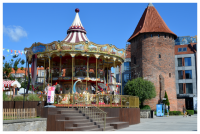
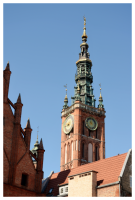
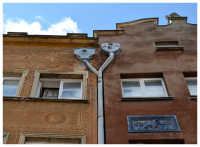
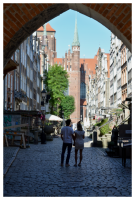
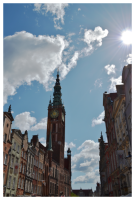
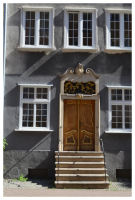
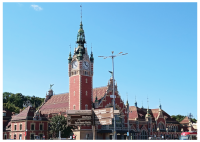
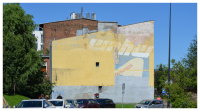
The Chapters
Day 1: Sunday, 28th of July 2024: All is well… | Day 2: Monday, 29th of July 2024: Getting Started | Day 3: Tuesday, 30th of July 2024: Something New(ish) | Day 4: Wednesday, 31st of July 2024: A Walk and Another Museum | Day 5: Thursday, 1st of August 2024: … That Ends Well
Author:
Chapter: 2/5
Length: 1977 words
Rating: 6+
Genre: travelogue
A/N: feel free to read; I wrote this mainly for myself, to better remember my time in Gdańsk
Summary: In the summer of 2024, I found myself with time and money to spend, and on short notice, decided to visit Gdańsk, a city I’d never been to, but had always wanted to see. Here, you can read all about my trip – the boring and hopefully not so boring details, illustrated by a couple of photos.
All was not better the next day. Shortly after midnight, I still wasn’t asleep, and I was in so much pain I was about to walk downstairs and ask for a doctor. It was one of the worst headaches I ever had in my entire life. As a last resort, I took an ibuprofen (with extra caffeine) for the pain and laid back down. And miraculously, I fell asleep.
The next morning, the pain was almost gone, but I still felt sick, tired and exhausted. I had a stuffy nose as well, which meant I was struggling with my allergies on top of the headache and stiff muscles. I wasn’t sure whether I was going to be able to do much of anything when I got up. I just had one last hope: breakfast. To be more precise: coffee. I schlepped myself downstairs, asked where the buffet was and got myself a large coffee with it. And then another, for good measure. Half an hour later, as if by magic, I felt like a human being again, and I was able to head out after all. I had three things on my itinerary for the day: get złoty, get my bearings, and acquire some postcards to send back home. I left the hotel around 9 o’clock.
First, I walked back towards the station, looking for either an ATM or a Kantor – a place for exchanging money. I passed by the cosmetic surgery clinic, then the other hotel, and then I reached a bank with an ATM where I withdrew two hundred złoty. The Kantor across the street was still closed. More than that, the entire city seemed to be somewhat sleepy, still. A couple of tourists were milling about, and other people were going to work, but apart from that, not much was happening. It was the perfect time to just walk around for a bit – much calmer and fewer distractions than later on.
I walked into the street that was still cordoned off for car traffic and it didn’t take me long to get an idea of what was going on: on the street, there were a lot of stalls – mostly still closed or in the process of being set up – selling this and that. There was a market of some sort in town. Of course, it took me at least another hour of aimlessly walking around to spot the sign that told me what exactly was going on. It was St. Dominic’s Fair. I had never heard of it and hadn’t know it was happening at all, but every year starting in late July, Gdańsk hosts one of the biggest fairs of this kind in Europe. It dwarfed all the Christmas markets I’d been to and was spread out all over the city centre like a kraken crawling through the streets. I didn’t truly get a good grip on just how big it was for another day when I’d finally gotten an idea of the city’s layout. There were stalls for pretty much everything: beer, honey, kielbasa, cheeses, nougat, handcrafts of all sorts… it was quite overwhelming, in the best way.
But I had gotten distracted: I still had a mission that morning: first, I needed postcards. And I wanted to exchange some of my euros. I walked past at least another two Kantors that were either still closed or unmanned, meandering through the narrow cobblestone streets and looking at what the stalls had on offer until I eventually ended up at the Motława, the river flowing through Gdańsk and into a branch of the Vistula. I also finally caught a glimpse of Gdańsk’s most famous building, the port crane.
Gdańsk, once upon a time, was one of the most important Hanseatic cities in the Baltic. The Hanseatic League – for those of you who don’t know – was a sort of medieval trade federation that at one point was powerful enough to win a war against the king of Denmark. For that reason, it boasts some of the most impressive Brick Gothic architecture I’ve seen, as well as many merchant houses, richly decorated. It was also the reason the crane was constructed, originally (the current building is a post-war reconstruction, as are many buildings in Gdańsk) – its name tells you something about its function. It was used to load and unload ships, as well as mount masts on ships. Its German name (“Krantor”) is somewhat more informative. “Crane Gate”, since you can walk through it and marvel at the wooden wheels that could move tons. It’s not pretty, exactly, but it is a very unique building, one that I find beautiful because of its function, despite being a bit squat and plain.
Near the crane, I finally found a gift shop. One that was open, even. It sold the most cliched tchotchkes imaginable, and also postcards. I bought myself my first souvenir (a magnet with an image of the waterfront, prominently featuring the crane) and a couple of postcards. The person manning the shop was a bored teenager on her summer job, and she clearly wished the tourists would just go elsewhere – maybe not that great for the shop, but honestly, I could relate. She did at least tell me where I could get my hands on a couple of stamps: near Neptune’s Fountain.
Well, as it turned out, that was a tad more difficult to find than I imagined. After a short break to figure out who would get what card, I wrote a couple of sentences on each. Then I went looking. I found the Neptune statue easily enough – it’s one of Gdańsk’s main tourist attractions, Poland’s oldest working fountain and part of the Long Market, alongside a lot of pretty historic buildings, including the Artus Court and numerous other Renaissance buildings. One of those is the Main Town Hall, a beautiful reconstructed building with a carillon in the main tower that rang when I passed by at 11 o’clock. By that time, the tourists were out in full force, which meant I had to walk back and forth a little until I found my target in the adjacent Long Lane, with just as many pretty houses. The stylized posthorn was what tipped me off.
Inside the post office, there was an open room with ancient standing desks and seats in the middle, while the room was lined with counters behind bars. It’s been a while since I’ve seen a post office like that outside of movies, so I probably stared a little too long before finally figuring out where to draw my number and waiting my turn. I didn’t have to wait long, and despite not quite understanding what the woman on the other side of the counter said, I got three stamps, put them on the postcards and then shoved everything into the red postal box outside, hoping I did everything right.
In the Long Lane, I also finally found a Kantor that was open for business and exchanged a hundred of my euros for złoty, which meant I could finally relax. My tasks for the day were done. It was time to head back to the hotel to relax a little, so I did just that. I walked across the fair again, mentally marked a stall to buy something for a friend later and finally made a stop at the shopping centre near my hotel, which contained a Danish Netto, which I’d never been to before, but had heard good things about. There, I bought some peanuts and a bottle of Żubrówka (my late grandfather’s favourite vodka) to take back home with me.
After getting back to the hotel, I spent three hours napping. My head needed it.
To be sure, the first thing I did when heading back out was to get another coffee. The option closest to the hotel was a Starbucks, and I ordered an Iced Cold Brew coffee. Tall. I got a plastic cup with the aforementioned beverage, even if the name on it was “Doitia”, which in true Starbucks tradition is very much not my name, and not even close to the Polish version of it.
Properly caffeinated, I set off in search of a place to eat. Both the guidebook and the internet were raving about a pierogi/mandu restaurant, but since I hadn’t fully oriented myself, it took a while to get there. I paused near the Great Mill at a statue of Johannes Hevelius, with a gorgeous astronomy mural covering a building, took a photo, put down the camera—
—and it just broke. The lens just fell off. I spent a quarter of an hour trying to piece things back together, but a little plastic ring that was supposed to anchor the lens to the rest of the camera had fractured, and there was no way to repair it myself. At some point, perhaps years earlier, it must have gotten damaged, and then time did the rest. As I was fiddling with the lens, another tourist came up to me and handed me his phone so that I could take a picture of him and his girlfriend with the fair’s logo in the background. Shortly afterwards, I gave up and resigned myself to using my smartphone for the remainder of the trip.
The dumpling restaurant turned out to be a bust as well. I was quite obviously not the only one who had heard about how great it was, considering the line outside stretched way past the restaurant itself. I’d have to find a different place to eat.
And so I walked across the fair, most of all in search of the specific stall where I had spotted something that I wanted to gift to a friend. It took two passes, but eventually, I found the Steampunk jewellery stall and waited patiently until a family was done purchasing one item for everyone. I bought my gift and set off to explore some more.
After some aimless wandering, I ended up in St. Mary’s Basilica, a large, Brick Gothic behemoth of a church that dominates the centre of the city. The inside does not look quite as massive as the outside, with white walls and arches creating a sense of airiness. The floor and walls are covered with grave plates – many of them in German – and art sponsored by wealthy patrons from hundreds of years ago. I was especially amused to note that a version of my name showed up a lot.
When I exited the basilica, I finally found a place to eat: the Indian restaurant next door. Maybe not the most authentic choice, but beggars can’t be choosers and my dietary restrictions can complicate things a lot. I ate Vindaloo Paneer, which I loved. Then I took another stroll through Mariacka Street, this time taking more time to look at it than I had in the morning. Its characteristic feature – besides the pretty townhouses and the amber jewellery displays – is perrons, with steps leading both up and down to the many, many jewellery stores.
It was at this point that I decided I’d done enough for the day. My feet were starting to hurt (I barely have any callouses, so I knew it was blisters), and I’d done what I wanted. I limped back towards the hotel, and on the way, I finally got a good look at the train station – I’d been so glad to see the back of it the day before, I hadn’t even bothered to turn around. It’s a beautiful (restored) 19th-century building reminiscent of the medieval Brick Gothic and renaissance architecture found in the city, with white highlights added to the sides. Truly, one of the most beautiful train stations I’ve ever seen!
But that was it for the day. I spent the rest of it watching Netflix and resting my feet; they’d suffered enough the next day.







